|
 AUSTRALIA: Judicial and prison CP AUSTRALIA: Judicial and prison CP
There is no JCP anywhere in Australia. It was outlawed for federal offences by the Crimes Act 1914, but this did not affect the local provisions in each individual State, some of which formally abolished it only relatively recently.
Benson and Glover (1931) stated that JCP was available in all States both for adults and for juveniles, but not widely used in practice.
The following information about the former position in each State is gleaned, except where otherwise stated, from Benson & Glover (1931), Benson (1937), Cadogan (1938) and Kalet Smith (1949).
New South Wales had rules prescribing the use of a tawse for boys under 18, for a range of crimes (or for any indictable offence, in the case of a boy under 16), with a maximum of 25 strokes (or 50 strokes if over 16) at each of three whippings. These punishments were inflicted in a prison. The prison service supplied two implements, "Tawse No 1" for boys under 14, and a larger "Tawse No 2" for youths over 14 and under 18. This 1884 news report makes clear that the tawse was applied to the bare buttocks of the offender, who was tied to a wooden bench.
Men over 18 convicted in NSW of serious sexual crimes and some other offences (violent robbery, but also e.g. "malicious wounding of cattle") could be given up to 50 lashes of the cat-o'-nine-tails at each of three whippings. This 1883 news item reports on what it says was the first such JCP sentence under the then new Criminal Law Act.
Before that 1880s legislation, courts in NSW ordered men to receive "lashes on the breech" (precise nature of the implement not stated), the earliest case currently to hand being this one in 1824; see also this 1841 case.
As at 1937, no adult JCP had been imposed since 1905, and no juvenile tawsings since 1932.
Boys aged 10 to 14 could also be summarily whipped with an instrument to be prescribed, and Cadogan mistakenly gives the impression that this had also died out, but this April 1936 report (on a NSW case, despite being in a Tasmania newspaper) makes it clear that birchings for boys at a magistrate's court were not uncommon at that time.
In Queensland the implement could be a cane, birch, or leather strap, or (for offenders over 16) the cat, with the same maxima as for New South Wales. In 1937 it was claimed that no JCP had been ordered "in recent years", but this overlooks a July 1934 case in which an aborigine was ordered at Cairns to receive "20 strokes with a leather strop on the bare buttocks". See also this April 1932 news report of a case in which a 17-year-old's father agreed with the court to give the boy nine strokes of the cane on his bare buttocks in the presence of a police sergeant, on which condition he would be released on a good behaviour bond. This kind of "semi-official" JCP seems to have been common in several Australian states.
There was provision in South Australia for offenders under 16 to be birched with up to 25 strokes at each of two whippings for certain offences including minor larceny, indecent exposure, and "writing obscene words on walls". For boys under 14, for any offence, courts could also invite the parents to administer a caning under police supervision, and then dismiss the charge once it was satisfied that this had been done. Adult men received up to 50 strokes with the cat, again at each of up to three whippings, all of which had to be administered within six months of the sentence. There had been four instances of this from 1932 to 1937.
Flogging with the cat for adult male offenders, and birching and parental caning for boys, were still in use in South Australia in the 1950s, as may be seen in several historical news items. The clearest picture of what the "parental caning" involved comes in this May 1956 illustrated news item, where it is interesting to note that one youth so caned was aged 17, despite the supposed upper limit of 14 (according to Cadogan).
As late as March 1961, two teenagers who had set fire to a school in Adelaide were sent to a reformatory, and also ordered while there to receive 10 strokes of the cane each.
A 1961 paper by the local Howard League set out some more detail of the modus operandi (see External links, at the bottom of this page).
Tasmania is listed as "none" in Cadogan, and not mentioned at all in Benson, but this appears to mean only that no information had been obtained, not that there was no JCP there. Certainly Tasmania had legislation providing for juveniles to be whipped. This 1889 news item describes a case in which a 16-year-old offender was given the maximum 15 strokes of the cane on his bare buttocks in the first of two whippings ordered by the court, with the second due to take place six months into his five-year prison sentence for assault. That was a Supreme Court case, but magistrates, too, were empowered to order JCP for juvenile offenders, using a cane, birch or strap, under the (Tasmania) Juvenile Offenders Act 1875 -- see Documents below.
Adult men in early Tasmania could be ordered by local courts to receive "lashes on the breech", as in these May 1834 news items.
In Victoria there was provision under 1928 legislation for boys under 16 to be caned on summary conviction for any offence, which punishment "shall not exceed in degree or severity such as may lawfully be inflicted by schoolmasters", perhaps suggesting that this penalty was delivered over the offender's trousers. There was also a "parental caning with no conviction recorded" option, similar to that in South Australia. More serious offences were punished on the bare posterior with a birch "consisting of willow withes soaked in water" or, for adult men, on the upper back with a cat-o'-nine-tails, with the same maxima as for South Australia. Birchings recorded in earlier times in Victoria include this one in 1886, in which a 19-year-old received 25 strokes for indecency, and this one in 1907, in which six boys received 15 strokes each for shopbreaking and larceny.
More recently there had been seven floggings in one year around 1930 in Victoria. As of 1937 there had been one juvenile birching and 10 adult floggings in the previous five years. But in the following year a young man and three youths were birched in one armed robbery case alone -- see this Dec 1938 news item. Another gang of young armed robbers, seven strong, were ordered to be birched in July 1942 in addition to prison terms.
In Western Australia the implement could be a cane, birch, or leather strap, or (for offenders over 18) the cat. Boys under 16 could be whipped for any offence on summary conviction under a 1927 statute. The maximum number of strokes was 12 for boys under 18, and 25 for adults.
There had been two floggings in one year around 1930 in Western Australia (one of which was 12 strokes of the "cat" for rape). In 1937 it was claimed that there had been no JCP in the previous five years.
A 19-year-old was sentenced in Perth to a 12-stroke birching for a sexual offence in 1962, and his appeal against it failed, as documented in this July 1962 news item, so presumably it was duly carried out. This could be the "last birching" (August 1962) referred to in one of the documents below (see "external links").
Formal legislative abolition took place in 1971 in South Australia, 1973 in Tasmania, and 1974 in New South Wales, the ACT and Northern Territory, according to this 1980 Law Reform Commission document  , which also stated that at that point JCP was still on the statute books in Victoria, Queensland and Western Australia. , which also stated that at that point JCP was still on the statute books in Victoria, Queensland and Western Australia.
In Victoria a Committee sat in 1948 to consider abolition of the birch or the cat or both, but its members could not agree. Abolition did not result: two Victoria criminals were ordered to be flogged with the cat in 1957, and the flogging was actually carried out the following year. A press report of the case stated that this was Victoria's first judicial whipping since 1943.
That case was said by the aforementioned 1980 Law Reform Commission paper (at para. 39) to be the "last officially sanctioned whipping in Australia", but there had been juvenile cases more recently than that in which courts ordered parents to administer formal CP to their sons (e.g. "Boys remanded for thrashing by father", The West Australian, Perth, 6 January 1970, not yet on line).
EQUIPMENT USED:
(click the thumbnail picture in each case to see the full-size image)
Corpun file 21961a
 Prison birch in its box Prison birch in its box
This is from Fremantle Prison near Perth. It is described as 9 to 12 birch twigs, bound together at one end with hemp cord. The spray is about 6 inches in circumference. "The birch was soaked in water before use. A long narrow table was used. The offender was not strapped to the table but his hands and feet were usually held." Evidently it lived in this wooden box when not in use.
The last birching at Fremantle was of a 19-year-old in 1962 for having sex with a 14-year-old girl -- see this July 1962 news report.
Corpun file 21961b
 Protective belt
Protective belt
Also from Fremantle Prison, this leather belt was placed around a convict's midriff during flogging with the cat on the upper back, to protect the kidneys.
Corpun file 20849
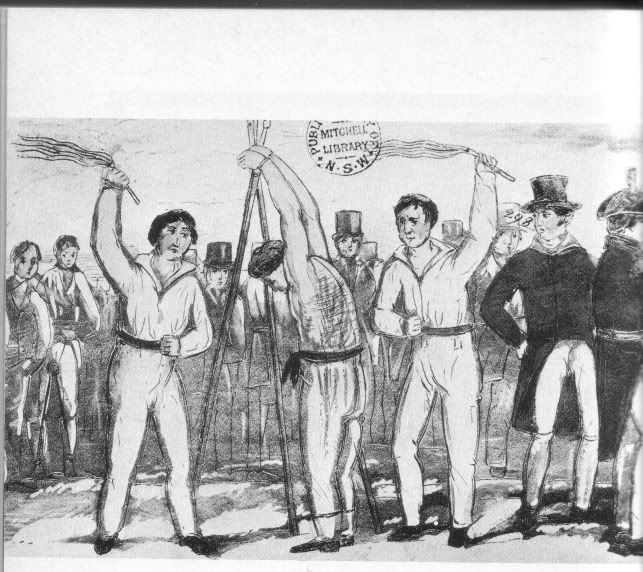 Flogging with cat-o'-nine-tails
Flogging with cat-o'-nine-tails
"The ritual of the cat-o'-nine-tails: a prisoner is flogged in Moreton Bay. Illustration in William Ross' pamphlet against the rule of Captain Logan, 'The cruel tyrant or the suffering prisoner', 1836." This somewhat crude drawing is in the Mitchell Library, Sydney.
Corpun file 19379d
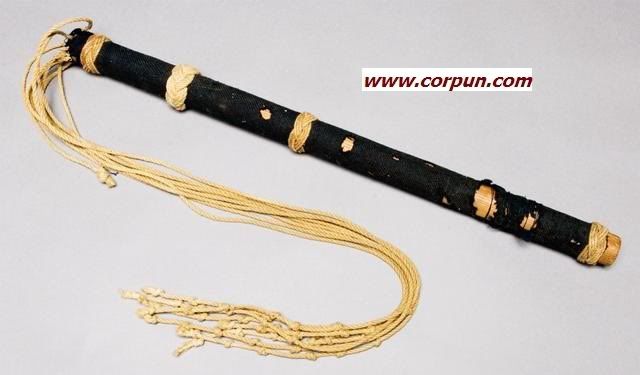 Cat-o'-nine-tails
Cat-o'-nine-tails
This is said to be a "standard weight, government issue" cat, no date or source. Despite the name, there appear to be only seven tails.
Corpun file 21464a
Yet another cat-o'-nine-tails
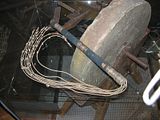
Similar to the above (but with eight tails visible), this one is at the Hyde Park Barracks museum in Sydney, which dates from the early 19th century. According to the information at the exhibition, about 10-15 men were flogged in any one day, in the prison courtyard.
Corpun file 19379a
Junior cat-o'-nine-tails

Implement that appeared at an Australian auction sale. It was described in the catalogue as "A leather lash as used on juveniles, c.1870".
Corpun file 19379b
Whipping bench
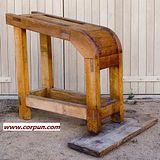
This is from the same auction. It is described as "A timber whipping stool c.1870, similar to the type used at Point Puer". Point Puer was the boys' prison at Port Arthur in Tasmania. We know from other sources that all the CP there was delivered to the bare seat. This apparatus clearly requires the recipient to bend over at an angle of almost 90 degrees. Obviously he stands on the wooden plank. Presumably his arms and legs would be attached to the contraption in some way, but there are no straps visible for this purpose.
UPDATE: A reader adds: The absence of any securing straps, as found in many other whipping contraptions, is easily explained. The youth's arms were inserted through the slots in the upper portion of the bench, and then his wrists tied together, securing him during his whipping, much as the inventive two-slot table used at Scotland's Inveraray Jail. Likely there was no need for his legs to be secured as well, as he would have been unable to turn his waist enough to risk the whip landing other than on his bare buttocks.
Corpun file 19379c
Leather lash for boys

Also from the same auction sale, this is described as "A leather lash used at Point Puer for the punishment of boys, c.1840" and came with a supporting document called "Point Puer juvenile punishment record, 11 August 1838" recording whippings of "ten to thirteen stripes on the breech".
Corpun file 21464b
Leather lash (2)
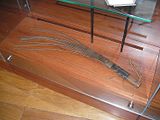
This exhibit at the Hyde Park Barracks Museum looks identical to the previous item, but is not described as being specifically for use on boys. The caption calls it "Whip or cat-o'-nine-tails, leather and wood, 1850s".
Corpun file 5036
Lashing triangle and implements, Melbourne

Commercial postcard from the Old Melbourne Gaol , now a museum, in Australia. The implements appear to be a cat, a birch and a cane. The flogging triangle itself resembles others we have seen, but the device attached to its front is unlike anything I have seen elsewhere. A reader who has visited the museum writes to say that this is a hinged pad, "something like a folding table, covered in green billiard-table-type felt", to be locked down for birching on the buttocks (with the prisoner bending over it) and kept in the illustrated upright position for flogging on the upper back. , now a museum, in Australia. The implements appear to be a cat, a birch and a cane. The flogging triangle itself resembles others we have seen, but the device attached to its front is unlike anything I have seen elsewhere. A reader who has visited the museum writes to say that this is a hinged pad, "something like a folding table, covered in green billiard-table-type felt", to be locked down for birching on the buttocks (with the prisoner bending over it) and kept in the illustrated upright position for flogging on the upper back.
Compare with the diagrams of English prison flogging apparatus in 1894 with removable padded block serving a similar purpose.
Corpun file 14947
Lashing triangle, another view and implements, another view

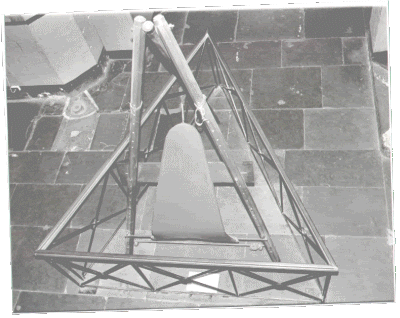
Different pictures of the same exhibits in Old Melbourne Gaol (see previous item), photographed by a reader. Here the triangle is viewed from above, and in the second photo the cat, birch and cane are seen more clearly.
Corpun file 14957
Melbourne triangle - yet another view

Another version of the Melbourne triangle. Here the hinged pad is a different colour. This one has a strap attached to it, for use during a birching. A reader who has seen it writes: "What was particularly effective about this strap was that it came up from the pad through small slits in the pad, then round the man's waist, then back into another slit in the pad about 12-15 inches apart from the first. This would have had the effect of holding the man's waist (and hence his buttocks) immobile. Rather than being able to twist and move from side to side -- even though his wrists and ankles were strapped down -- which could happen with a "Pakistan"-type frame, he was fixed so that he could not move at all."
Corpun file 14948
Whipping stand, Adelaide
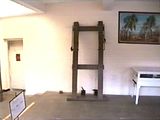
From Old Adelaide Gaol , another museum. It's not absolutely clear, but this looks like a frame that simply leaned against the wall and secured the prisoner in a standing upright position, which may mean that it was for flogging on the upper back only. It somewhat resembles the device in the inept Wandsworth drawing. , another museum. It's not absolutely clear, but this looks like a frame that simply leaned against the wall and secured the prisoner in a standing upright position, which may mean that it was for flogging on the upper back only. It somewhat resembles the device in the inept Wandsworth drawing.
Corpun file 14949
Another view of the above

This is a perhaps slightly clearer picture of the contraption in Old Adelaide Gaol (see previous item), taken from a book about the prison. It also includes, on the right, the handle of a birch (the rest of the implement would have disintegrated), and on the left, juvenile punishment canes. The latter are interesting, because the only juvenile judicial canings (as distinct from birchings) in Adelaide that I had heard of before were done at home under police supervision, not in prison - see this May 1956 illustrated news item.
UPDATE: The manager of Adelaide Gaol museum kindly informs me that there were indeed juvenile canings there, as well as birchings, in the 1940s and 1950s; and also that the apparatus in this picture is not one that was actually used at Adelaide Goal, but came from Yatala Labour Prison.
DOCUMENTS:
Tasmania: Juvenile Offenders Act 1875
Law authorising courts to impose strokes with a cane, strap or birch on boys under 19. Except for the unusually wide choice of implements, this largely follows the British terminology and practice of the era. Note that "once, twice or thrice whipped" here means one, two or three separate punishment sessions, separated by an interval of at least 24 hours, each involving several strokes.
South Australia: Criminal Law Consolidation Act 1935-1957
A clause added in 1940 made whipping mandatory for rape. Other clauses provided for a sentence of up to three whippings of 50 strokes each (25 for boys under 16).
EXTERNAL LINKS: (these will open in a new window) 
Corporal Punishment in South Australia
1961 paper by the South Australia branch of the Howard League for Penal Reform. Judicial CP in SA consisted of "flogging on the bare back with a cat-o'-nine-tails" for males over 16, and "caning on the bare buttocks" for juveniles. In the latter case, the offender was "bent over a table and held down", with a maximum of 25 strokes at each of up to three caning sessions. It was carried out by officers of the Prisons Department. "Caning can also be ordered to be carried out by a relative of the juvenile in the presence of a police officer." In the latest ten years, 17 adults had been flogged and five juveniles caned.
Prison Telegraph: Crime and Punishment [PDF]
Educational handout from Fremantle Prison in Western Australia. According to this, the last flogging with the cat at Fremantle was in June 1943, and the last birching in August 1962. It is not made clear whether these were ordered by a court or by visiting magistrates for reasons of internal prison discipline. The document also claims that JCP was not formally abolished in Western Australia until 1993, which seems surprisingly recent.
 References: References:
-- Benson, George, and Glover, Edward, Corporal punishment: An indictment, Howard League for Penal Reform, London, 1931 (in particular Appendix I, "The law and practice of other countries").
-- Benson, Sir George, Flogging: The law and practice in England, Howard League for Penal Reform, London, 1937 (in particular Appendix I, "The law and practice of other countries").
-- Cadogan Report (Report of the Departmental Committee on Corporal Punishment), London, 1938 (in particular Appendix V, "The law relating to corporal punishment in certain foreign countries and in His Majesty's Dominions").
-- Kalet Smith, Anna, Juvenile Court laws in foreign countries, Children's Bureau, Social Security Administration, US Federal Security Agency, Washington DC, 1949
| 














